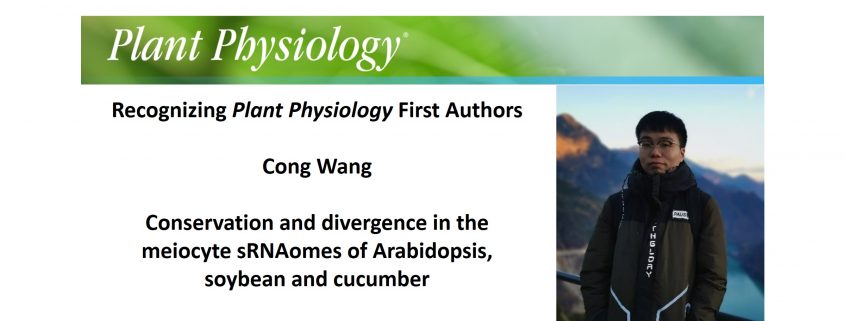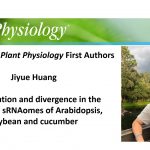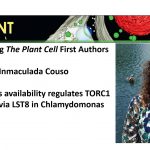Recognizing Plant Physiology authors: Cong Wang
Cong Wang, co-first author of Conservation and divergence in the meiocyte sRNAomes of Arabidopsis, soybean and cucumber
Current Position: Post-doctoral fellow. Plant Biology, Fudan University, China
Education: Ph.D. Biochemistry and Molecule Biology, Sep. 2013-Jan. 2019. Fudan University, China; B.S. Biological Science, Sep. 2009-Jul. 2013. Lanzhou University, China
Non-scientific Interests: travelling, reading, and movies
Brief bio: From my Ph.D study up to now, it is my great honor to obtain an opportunity for pursuing plant reproductive biology researches advised by Drs. Ma and Wang at Fudan University. I was trained in cytobiology, molecular biology, biochemistry, genetics, and transcriptomes. My project mainly focuses on two aspects: One is to address regulatory networks of DNA polymerases in meiotic recombination, such as POL δ and POL ε. The other is to elucidate the epigenetic regulatory mechanisms during meiosis, including small interfering RNAs, histone methylation, and meiotic gene silencing and chromatin condensation. This project has led to the discovery of different landscapes and roles of meiotic and mitotic small RNA, providing new insights into how sRNAs relate to gene expression in meiocytes and meiotic recombination in Arabidopsis. Furthermore, we have driven our discovery of the meiocyte-specific sRNAs (ms-sRNAs) in two crops (soybean and cucumber) and found similar characteristics to that in Arabidopsis. We also identified the profiles of microRNAs (miRNAs) and phased secondary small interfering RNAs (phasiRNAs) of meiocytes in these species. Currently, I am working on special mechanism of chromatin condensation and gene silencing in meiosis.
王聪
目前职位: 博士后,复旦大学,生物学流动站
教育经历:
中国,复旦大学,生物化学与分子生物学专业,博士(2013.09-2019.01)
中国,兰州大学,生物科学专业,理学学士(2009.09-2013.06)
本人简介:
从兰州大学本科毕业后,我很荣幸地加入了复旦大学马红教授和王应祥研究员的团队从事植物生殖生物学的研究。在此期间,我接受了细胞生物学、分子生物学、生物化学、遗传学和组学分析等方面的科研训练。在博士研究生涯中,我的科研方向是植物减数分裂,主要工作集中在以下两个方面:
1、DNA合成因子调控减数分裂重组的作用网络,特别是后随链合成在减数分裂重组中的作用。我们运用减数分裂特异的基因沉默技术,分析了DNA后随链合成聚合酶δ(AtPOLD1)在减数分裂重组中的具体功能,结果发现降低POLD1的表达,会影响减数分裂同源染色体联会和重组,产生大量染色体碎片,最终导致植物育性降低。通过进一步对不同重组的类型进行定量,发现POLD1主要影响干涉敏感型重组通路,且其功能可能独立于前导链延伸聚合酶ε。该结果进一步加强了减数分裂重组需要DNA后随链合成因子的观点,完善了DNA合成因子参与减数分裂重组的模型。
2、探究减数分裂过程中的表观遗传调控机制,包括sRNA、组蛋白甲基化、基因沉默和染色质浓缩等。首先,我们通过对拟南芥减数分裂细胞和体细胞的组学分析发现了减数分裂细胞特异的ms-sRNA(meiocyte-specific small RNA)集群,不同于体细胞siRNA主要分布在异染色质区并且抑制转座子和基因的表达,其主要分布在常染色质的基因编码区,且与基因表达正相关。此外,我们还发现DSB依赖的ms-sRNAs富集于重组发生的热区,并和重组偶联的DNA基序显著关联。而目前我们已经将该研究推进到重要经济作物大豆和黄瓜中,发现了其中ms-sRNA的特征类似于拟南芥,该工作进一步揭示了减数分裂特异小RNA的与减数分裂表达基因和重组的关系分裂重组的关系。另外我们还比较并鉴定了三个物种中减数分裂特异的microRNAs (miRNAs) 和phased secondary small interfering RNAs (phasiRNAs) 及其特征。
目前,我进行关于调控减数分裂基因沉默和染色质浓缩相关机制,以及表观遗传修饰对于减数分裂重组影响的相关研究。




